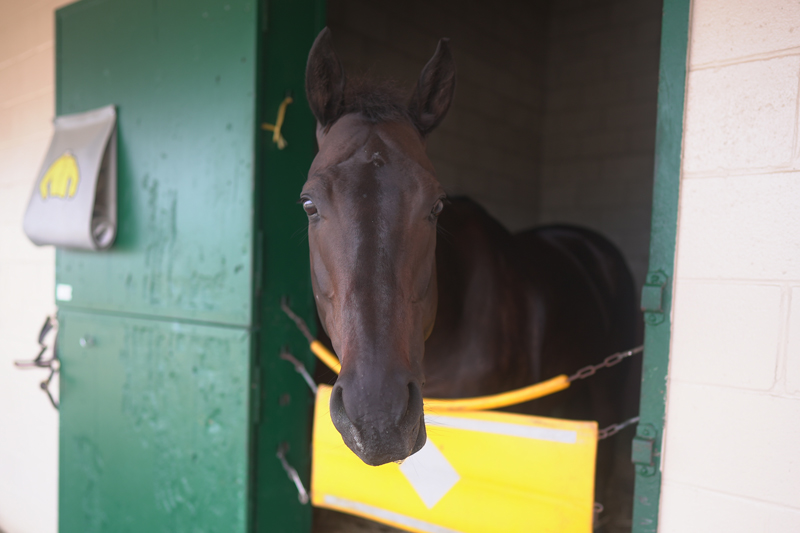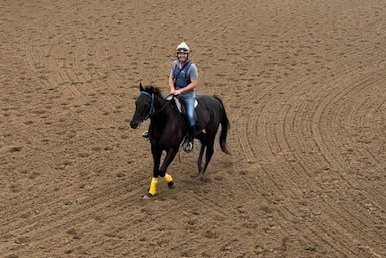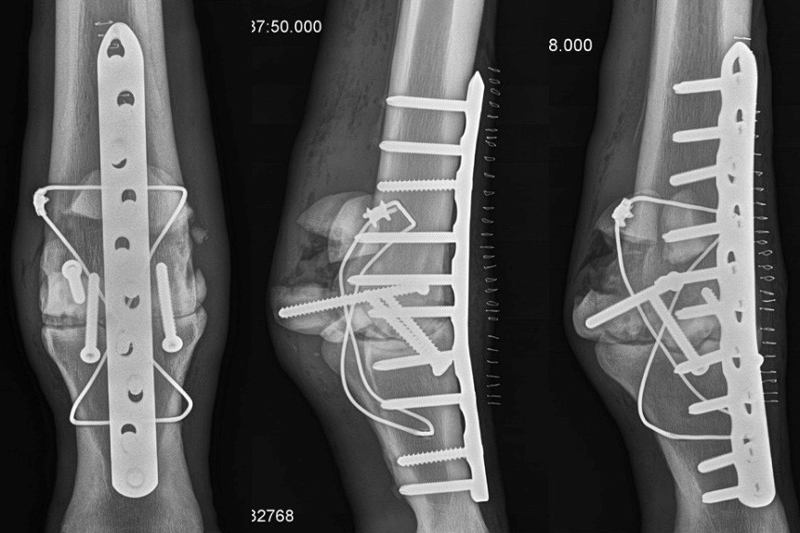
Smokin Blackjack (David Woods)
By Brigitte Becko
Thoroughbreds are considered the fastest horses on earth, even holding a Guinness World Record for the fastest horse in the world. Winning Brew was clocked at 43.97 mph at a racetrack in Grantville, Pennsylvania in May of 2008. We saw another version of sheer speed and grace at Del Mar last year in the G1 TVG Pacific Classic. The grandstand echoed with excitement at the sight of Flightline’s 19 1/4-length win.
But what happens to these Thoroughbreds after racing? Not just when they are led back to their barn, bathed and fed a carrot or mint for their hard work, but after their careers are finished. Some go off to breeding farms to create the next generation of runners. Others go into new careers with the intention of winning more medals.
For some, though, injury comes first, and recovery becomes the priority even before thinking of that new career. A prime example would be a gelding that raced for two years, suffered an injury, went through surgery and therapy and is now back at Del Mar as a pony escorting racehorses, some of which he raced against.
On April 15, 2016, a dark bay colt was brought into the world, sired in California by Atticus out of the mare Nossa Cancao. His racing name became Smokin Blackjack. With trainer Bill Delia guiding him, he started racing up at Golden Gate Fields with Austin Solis as his rider. Solis is now retired from riding and is an exercise rider and foreman for trainer Richard Mandella. Solis was onboard when Smokin Blackjack notched his first victory in December of 2018.
“I had a good feeling about the horse,” Solis says now. “I had a connection with Bill Delia and his family.”
Smokin Blackjack won his debut race by a nose with Solis smiling from ear to ear.
“It’s a great feeling,” Solis says.
Bill Delia was a jockey for 19 years with over 300 wins, then a respected trainer for 35 years with over 900 wins. Unfortunately, Delia passed in 2020 due to complications surrounding COVID-19.
“Bill Delia was a great guy,” Solis reminisced. “I am a pretty happy guy myself and there’s not many people who are smiling with me at 4 a.m.”
With multiple trainers, such as Mark Glatt and Leonard Powell, taking Smokin Blackjack under their wings, he had a promising young career. He raced here at Del Mar in his last few races with Juan Hernandez as his rider. His last outing was a 1,000-yard allowance race at Los Alamitos on November 1, 2020, where he showed speed, then faded to finish fourth.
Nineteen days later, while galloping during a training session, Smokin Blackjack sustained a leg injury. Fortunately, track veterinarians acted quickly, and ‘Blackjack’ was taken into immediate surgery.
The head surgeon Dr. Ryan Carpenter, and his assistant surgeon Laurie Bohannon, with anesthesiologist Cathy Cornfield, went right to work.
His injury was to both sesamoid bones in the left front fetlock joint region. The surgery they performed was a fetlock arthrodesis, a procedure in which the fetlock joint is fused.
“It’s key is to minimize table time with these horses” Dr. Bohannon says, “for the best bounce back possible.”
Smokin Blackjack also was diagnosed with foot lock arthritis in his left foot. Dr. Bohannon says it’s a pre-existing problem within some horses and is possible to catch in time before any accidents happen through a PET scan. With advanced diagnostics like this, doctors are able to find the problems before any injuries occur.
“The main thing to keep in mind is allowing the foot to stay with good blood supply during an injury of this sort,” Bohannon explains.
Although this is a career-ending injury, Dr. Bohannon says she decided to buy Smokin Blackjack to ensure that his surgery was the right thing to do for him. The same injury that ‘Blackjack’ had suffered cost horses their careers and sometimes their lives. There was no technology or advancements in medicine to humanely help these horses at the time. Now that there is, doctors do all that they can to help.
Dr. Bohannon, who now is Santa Anita Park’s senior veterinarian for The Stronach Group under chief officer Dr. Dionne Benson, says three years after the incident Smokin Blackjack still has “lots of heart and a kind soul.” C J Wilson, founder and lead trainer with the Win Place Home program up in LA, an ex-racehorse charity, helped the horse with his rehab therapy.
Dr. Bohannon has had him for a year with it being three years since his surgery. Now a pony here at Del Mar, she says “he likes to jump” and that she is “excited to see where he goes.”

Surgeon Ryan Carpenter was raised around animals and animal health piqued his interest. He would frequent the local veterinarian and after junior college he started volunteering at Humphrey, Giacopuzzi & Associates Equine Hospital.
“It’s the only equine hospital in Ventura County that is staffed 24/7,” Dr. Carpenter explains. “They have both a doctor and a technician on site to provide around-the-clock intensive and emergency care including colic, neurological, neonatal, ophthalmic and reproductive cases.”
Dr. Carpenter saw lots of medical procedures there. One that he remembers was a horse that came in with a bad case of colic. He watched how surgeons helped the horse in pain.
“To watch this horse come in with such pain,” Dr. Carpenter recalls, “and then to wake up with happiness and relief.” He knew then that this kind of work was for him.
Surgery became his next goal. He turned to Cal Poly for his undergrad and took a step further to the best-rated veterinarian school in the country, U.C. Davis.
His most memorable class focused on the biological standpoint of muscles, tendons and bone. He got into research through the professor from the class for biomechanical testing, through the orthopedic side. His veterinarian school research focused on condylar fractures, which is common for foot lock among racehorses. They were testing to see if the similar procedure done on humans was possible for horses. His professor recommended Dr. Carpenter work at a racetrack, encouraging him to experience the reality of horse races and active veterinarian work.
During his senior year in vet school, he came to Del Mar for two weeks and said it was a “cool job.” He got hooked on watching racehorses ever since.
“To be a part of a team of doctors working with the same group of athletes,” Dr. Carpenter explains, “the same horses, day in and day out, was comforting.”
After graduating he came back to Del Mar for a year as an intern and did his surgical residence at the University of Colorado in Fort Collins. He loved racing so he came back to Southern California for more.
“There are so many positive stories that come out of surgery,” Dr. Carpenter explained. “Smokin Blackjack is definitely one of our shining stars.”
He explained how they were able to get ‘Blackjack’ back on his feet again.
“There was a plate, screws and wires around his cannon bone to lock his foot in place,” he says. “He wore a cast for about two weeks in recovery and went to a farm afterwards for about four weeks for slow working therapy.
“Some horses with this sort of surgery take longer to recover, some 8-to-10 weeks,” he continues. “The point of this recovery time is to have time off from big movements or any sort of exercise.”
The time off allows for the bone to fuse to the joint and heal itself for the horse to be able to get back to walking again. As many know, horses are constantly moving creatures and are on their legs for most of their lives. This time off strengthens their bones so that they can begin exercising.
Dr. Carpenter volunteers surgeries for CARMA, working mostly on fractures that need to be repaired.
“The least I can do to give back (to these horses),” Dr. Carpenter says. “It helps give them a second chance at life.”
His purpose in volunteering his services is to see them back on the track, racing. He says he has watched some of the horses he has worked on race in Grade I and Grade II’s and even in the Breeders’ Cup.
“A vast majority (of my work) is to restore these horses’ athletic performances,” he says. “Historically people view this as a burden for the horses, but what is very evident, especially with ‘Blackjack,’ is we give them a pain free life and new career, giving them a second chance.”
Win Place Home is a California-based, non-profit organization offering former racehorses a transition from racing. In their mission statement they add that they have created a safe space for the horses to re-train in different professions as “functioning members of new disciplines.”
They also have rehabilitation services allowing these horses the ability to retire to a farm or, as they like to call it, a ‘forever home’. The people working within this organization have experience within horse racing, dressage, hunter/jumper, therapy, trail riding and many more to give these horses the opportunity to see what career best fits them. They’re current operations are out of Birtwick Park Equestrian Center in Canyon Country in Santa Clarita.
“I think they can do anything,” says Lucinda Lovitt, the executive director of CARMA. “Most Thoroughbreds want a job where they feel useful and are around humans. Thoroughbreds are very emotional animals and tend to want human interaction.”
One of Win Place Home’s goals is aiding the influencing of public opinion on racehorses.
“We hope to change the way people view off-track Thoroughbreds,” their mission statement reads. “Not as high-strung, flighty or untrainable, but as determined, strong horses with a desire to learn and give back.”
“This is yet another opportunity for these ex-racehorses to begin a new life off the track to train for a different career,” according to Lovitt. “Horses that go through these programs are fitted with a new life based on their personality, temperament and pre-existing conditions.
“We are the first transitional step for these horses,” Lovitt continues, “providing triage, if you will, so charity partners such as Win Place Home and United Pegasus Foundation don’t have to spend valuable donor dollars on lay-ups.”
Lay-ups allow the horse time off to relax, get used to a barn setting without the high-energy competitiveness that surrounds the track environment. If injured, these horses get the best medical care they need. This in-between home allows their care-takers to assess their personalities and medical history to best fit them with a partnered charity to eventually find them their forever home. This then allows these charitable partners to fulfill their missions, such as adopting, retraining or retirement and rehabilitation spaces.
CARMA acts a middle-man of sorts for horses coming from on-track racing to off-track retirement. The abbreviation of the organization stands for California Retirement Management Account and it’s a non-profit organization. Lovitt explains that they are a reliable resource for “owners and trainers to retire their horses from racing.”
“It’s all about fitting the right horse to the right program,” she explains. “We strive to find them the best match so that they and the charity have the best success in finding them a permanent home.”
Lovitt elaborates about their working relationship with racetracks and the California Horse Racing Board (CHRB) that allows them to do this work, although they still operate independently. CARMA worked with the CHRB adopting a rule change for a deduction from purses to fund the equine retirement organization in California.
“This deduction, which owners, trainers and jockeys can “opt-out” of if they so choose,” Lovitt says, “is used to support Thoroughbred retirement farms and other non-profit programs that care for and retrain retired racehorses.”
A way to tell if a horse is eligible for the Placement Program is to take a look at the three major requirements for a horses’ ability to join the program. One being that the owners of the horse must participate in the purse contribution program adopted by the California Horse Racing Board. Second is the horse must have raced at Santa Anita Park, Del Mar, Los Alamitos, Golden Gate Fields, or any main California racetrack in the last six months. Finally the horse must be a gelding, filly or mare.”




